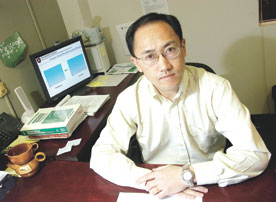Yong Zeng develops the new science of design

Yong Zeng
Photo by Vincenzo D’Alto
When Yong Zeng began work at the Concordia Institute for Information Systems Engineering (CIISE) as an associate professor last August, he didn’t waste any time.
Two days later, he started putting together a proposal for a Canada Research Chair in Design Science. Earlier this month, it became one of seven new Canada Research Chairs awarded to Concordia.
Zeng’s research has two central goals. One is to establish a formal science to understand design activities. The other is to develop computer-aided conceptual tools for design and manufacturing industries.
He explained in an interview that design science is a new field that tries to explain “what is going on in the designer’s mind. This is the first step toward developing tools to assist designers with their activities.”
Zeng has proposed a “logic of design” that tries to capture the fundamental nature of the design process, and to reveal the logic that underlies creativity and leads to the solution of a design problem.
He approaches this research in several ways, from studying philosophy to videotaping designers as they solve problems, looking for underlying patterns in their activities.
In developing computer-aided design systems, or software, Zeng said, “it is important to reflect the needs of designers, and leave room for them to do their creative work.”
The first step is to create a software system that can manage design data without disturbing the designer’s work. Second, he designs software that does some repetitive tasks, and thus allows the individual to focus on more creative activities. Finally, he develops software that can do some aspects of design work by itself.
Zeng’s software deals with three fields: geometric design, which he began working on 10 years ago in China, and continues to develop today; architectural design, such as the layout of a building; and most recently, software for mechanical and manufacturing industries, primarily automobiles and medical devices.
Before coming to Concordia, he was involved in a project to create a natural user interface for designers. He and his colleagues developed a sketch-based mechanical design system that allows a designer to use a computer system as if it were a pencil and paper.
In another project, they used cameras and scanners to create a 3D image of a real manufactured object so the designer can experiment on and improve the object. Zeng is now using a similar technique to help a medical devices company design better products.
Zeng was born in China. He received his first PhD, in computational mechanics (a field of engineering that develops computer software for engineering analysis), from Dalian University of Technology in 1992. After teaching in China for four years, he decided to do a second PhD, and completed a doctorate in design engineering at the University of Calgary in 2001.
He had a fruitful stay of over a year with the National Research Council’s Integrated Manufacturing Technologies Institute in London, Ont. Then he started job-hunting again, looking for an academic position that would combine his background in engineering, computer science and mathematics.
An offer from CIISE director Rachida Dssouli fit the bill. The CIISE is an interdisciplinary research and training institute that focuses on innovative applications of information systems (tools based on the discipline of computer science) to a wide range of engineering research fields.